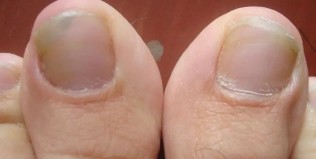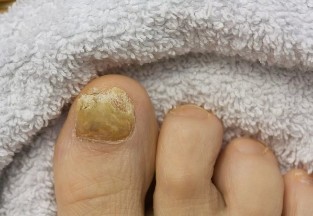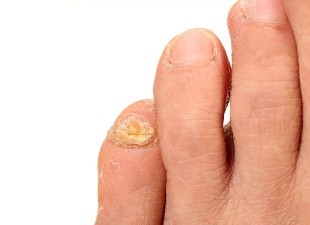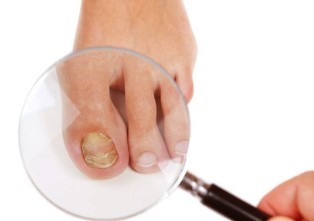There is hardly a Person, never heard about such diseases as nail fungus. Someone familiar with the diagnosis from the advertising of pharmacological agents, and someone learned first-Hand about the disease came from the office of a dermatologist or self-diagnosed.

Definition
The medical term, onychomycosis (Lat. onychomycosis) is Latin and means nail fungus, and is used for the name of the infectious disease fungal in nature. It is the most common in the world of the lesion of the nail plate and the adjacent soft parts to it: according to statistics of the world health organization (who), Mycosis of the feet, about 27 % of the people suffers, although this figure is almost twice as high, the number of fungal infections of the nails on the fingers.
Species of fungus of the nails diseases
Onychomycosis categorize after the appearance of the person concerned. Since the character of the classification is, looks like fungus on the nails, it is differentiated into three types, depending on the clinical Manifestation:
- atrophic, or onycholitic – in which the nail plate is affected significantly by the degree of repulsion from the nail bed;
- hypertrophic type, in which the loser is changing in the natural Shine nail color (white, or Vice versa, it will be dark) and structure (a clear, thickened) with the advent of various types of deformations and even on the edges destroyed;
- normotroficheskie – look, characterized by the low degree of the lesion of the nail plate is not thickened, consistent, shiny and smooth, but still externally, its natural transparency, and color is transformed by the occurrence on it spots, marks and other visible changes.
There is a further classification, according to which of the fungus on the nails is divided into types depending on the location of the lesion:
- in total, the disease-causing process by the whole of the nail plate;
- distal – the Form of the defeat only to the free edge of the nail extends beyond the fingers;
- the proximal, in which the edge of the plate, the break-under the nail fold (the opposite free edge of the nail!);
- the lateral shape of the lesion, effects on the sides of the nail plate.

How does pathology
Widespread among the population, fungal nail disease is a similarity in appearance with other dermatological diseases are not fungal in nature. Depending on the stage of the pathology, start the nails, unhealthy appearance, since the natural Shine and transparency to lose.
From the smooth and flat, they are thick and deformed, and with different colors (mostly white or dirty yellow) flower. Soft parts, destructible parasite keratin layer of the inflammatory reactions involved in swelling.
If it is a picture of the destruction of the nail plate perspective in the dynamics of the disease, then it is possible to a limited extent, divided into three successive stages:
- On the first level, almost no symptoms, except slight dullness, spots or streaks on the plate.
- On the so-called "heavy" Phase, fast-paced to Start, all onychomycosis symptoms significantly.
- Phase – is the ultimate Degeneration of the nail, can be supplemented by the emergence of unpleasant smell of rotting.
Symptoms of the fungus on the nails
The appearance of the symptoms of fungal infection corresponds to the conventional chronology of the development of pathogenic process whose speed depends on both the type of the pathogen and the individual health condition of the sick.
How do you determine the fungus on the nails before the visit of the Cabinet of doctor skin? Exactly to the typical symptoms, accompanying fungal infection of the nail plate on the fingers:
- First nail plate lose shiny luster, become dull and uneven.
- Then, a transparent and pink nail changes color, becoming whitish, grey or dirty-yellow.
- The thickness of the plate increases.
- On the surface of the organ defects appear in the Form of stripes, waves, bumps, curves, etc.
- In the case of nail brittle appears, he starts Peeling and crumbling.
- The Finger due to the inflammatory processes begin to have an unpleasant smell.

At the end, completely destroyed the nail onycholysis exposed to spalling, i.e., exposing the pringtime of the Lodge.
Causes of onychomycosis
Pathology is a Manifestation of the mycosis, which is a defeat in this case, the nail plate of micro-organisms by dermatophytes one (or more!) made up of three genera:
- Microsporum (species canis);
- Trichophyton (species rubrum – 90% of all fungal infections, mentagrophytes, interdigitale, and tonsurans) – most common causative agents of mycoses;
- Yeast (type floccosum).
Representatives of all three genera combined the short form of the name "nail fungus", when entering the body, colonize (i.e., locate) Horny derivative of the Epidermis of the skin:
- Nails;
- Hair.
The reason for this selectivity of habitats and micro-parasites in your diet: all representatives as a source of energy fibrillary Protein Keratin, to destroy the nails and hair.
Methods of infection
All types of pathogens contact method to be transferred:
- Body contact from an infected Person to a healthy;
- about the things that are in contact with the body part (shoes, items of personal use, etc.).
The contact with the finger nails or the skin, which is the habitat of the parasites, the living representatives of the fungi to healthy areas of the body.
That the causative agent of onychomycosis, the Infiltration into the tissue of man, such conditions are not required to work, such as:
- Damage to the integrity of the skin (Dermatitis, diaper dermatitis, circulatory and skin diseases, abrasions, wounds, etc.);
- weakened immunity;
- the presence of concomitant diseases (genodermatosis, and hemolytic disease, immune -, and endocrine diseases);
- the intake of cytotoxic and hormonal drugs as well as antibiotics.

In connection with the above, the penetration of the parasite in the body of a healthy person is not, in all cases, without exception, leads to the clinical manifestations of the disease, or only very weak forms of pathology.
Due to certain individual requirements, including a strong immune system, a Person remain outwardly healthy, it will infect the carrier of the parasite to other people.
How to recognize the disease
On the basis of the external similarity of mycotic low other diseases of the nail plate layers with mechanical waves and the symptoms, the basis of the clinical diagnosis is only external signs — such as nail looks fungus, but also explain the results of the micro-studies.
For laboratory studies, the particles of the phases of the affected nail to be witnesses, thereby scraping on the nail fungus, using special tools.
A certain type of parasites found, with the help of two practical studies:
- Culture, by building a biological sample of the affected tissue in a special breeding ground;
- molecular-biological method, or the so-called Polymerase chain reaction (PCR).
More accurate and informative DNA diagnosis is still not sufficiently widespread.
In the answer to the question: "how to recognize nail fungus home", experienced dermatologists advised to contact a specialist for the implementation of a comprehensive and in necessary cases and differential diagnosis, diagnosis.
How dangerous is nail fungus
Uncomplicated nail fungus symptoms, although unpleasant, but traditional for fungal infections: stratification of the nail, pain sensations, etc.
But in some cases mycotic can, for example, a bacterial infection or disease can occur acutely, with the appearance of blisters, ulcers, weeping areas on the adjacent soft parts.
Happens, drug therapy, long-term outpatient (more than 16 weeks!), not inefficient, and the disease progresses.
How dangerous is nail fungus, long not treatable? In the inflammatory process involved organs and their System, and then may need emergency room in a hospital patient.
Methods of treatment of fungus on the nails
In the early stages of the disease, the school of medicine adheres to conservative methods, through the appointment of the drug treatment.
Anti-mycotic drugs developed to destroy the fungus under the nail, contain substances that are able to actively suppress, the basis of life of its various stamps. For efficient therapy, various pharmacological forms, sometimes assignable to be comprehensive:
- Tablets — for the adoption of oral (through the gastrointestinal tract, generally with water), in the absence of the desired effect of Outdoor medicine;
- Ointments, pastes and gels for local, topical application, with the application of the product directly on the affected parasite part of the body;
- Aerosols;
- Solutions (resorcinol, boric acid, brilliant green, etc.) and the Suspension for applications in the medium-impregnated cloths to the affected areas or the use of the drug in the Form of medical baths.
Medicines external application is usually used twice a day, until the approval of the clinical manifestations. In the event of a significant keratosis to facilitate the Penetration of the dosage form Keratin deep into education, it is partially replacing. If signs of nail fungus to show on the accession of secondary bacterial infection, patients recommended combined antibiotic.
Important! If the recourse to the systemic Anti-mycotic agents for the control of possible functional disorders necessarily produce a biochemical liver (analysis of blood serum for the presence of Bilirubin, in the presence of the enzyme aspartate-Aminotransferase, Gamma-glutamyl transferase, etc.
Access if the Patient is to be treated, for example nail fungus on the big toe, appear suddenly acute inflammatory processes and/or severe itching, means:
- antihistaminicas (edema and inflammation);
- desensitize (decrease sensitivity).

Therapy through the use of pharmacological agents, in General, is, of course, and lasts a long time – at least three months!
This duration of treatment is due to the introduction of the pathogen into the structure of the nail, in connection with the need to have time to update it, step-by-step systematic circumcision in the affected areas. In the case when the disease is at a stage where the drug of the therapy, no positive results (total Form), or the Patient – the face of the age, to radical methods, surgeon remove Japanese parasite destroys the nail.
Prevention
The best treatment is a preventive activity, since the disease is to be prevented much easier than the first fungus to settle on the nail, and then get rid of it. Good ways to prevent the infection favors the strict observance of rules of personal Hygiene, especially in public, with the danger of potential contacts with native speakers of fungal infection as well as prevention:
- primary, exceptionally, in abnormal dryness of the skin, chafing, micro-and hyperhidrosis, but in the case of their occurrence a timely treatment, for example, Aluminium hydrochloride 15% with ditilinom glycol 1% in athlete's foot;
- Secondary disinfection with special solutions objects contact with fire place fungi (shoes, towels, etc.).
Possessing the correct media information, of which the fungus appears on the nails, it is realistic to protect yourself and your loved ones from infection, and, in the case of the disease in a timely and adequate therapies are able to speed up the recovery.































